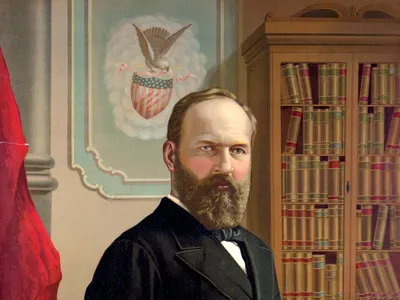risques-niger.org – James A. Garfield, the 20th President of the United States, had one of the shortest presidencies in American history. His time in office lasted only 199 days—cut short by an assassin’s bullet—yet his brief administration made a lasting impact on the nation. Garfield’s presidency is often remembered for his efforts toward civil service reform, his support for the rights of African Americans, and the tragic events surrounding his assassination. Garfield’s leadership, although limited by his short tenure, showcased his potential to guide the country through the challenges of the post-Reconstruction era.
Early Life and Career
James Abram Garfield was born on November 19, 1831, in Moreland Hills, Ohio, into a poor family. His father died when he was just two years old, and his mother struggled to support the family. Despite these challenges, Garfield was a gifted student, and his academic abilities earned him a place at Williams College in Massachusetts, where he graduated in 1856.
After college, Garfield taught and later studied law, eventually becoming involved in politics. His career was interrupted by the outbreak of the Civil War in 1861, where he joined the Union Army as a lieutenant colonel. Garfield quickly rose through the ranks due to his leadership abilities and was promoted to major general. His service in the war, particularly his successful command in the Battle of Middle Creek in 1862, earned him national recognition.
After the war, Garfield served in the U.S. House of Representatives from 1863 to 1880, where he established a reputation as a strong advocate for civil rights, education, and the preservation of the Union’s post-war policies. He was a member of the Republican Party and became involved in national issues, particularly in the areas of tariffs and the administration of the federal government.
The 1880 Election and Presidency
Garfield’s path to the presidency began in earnest at the Republican National Convention of 1880. Although Garfield was not initially a leading candidate, the convention deadlocked after multiple ballots, and he emerged as a compromise candidate. Garfield’s nomination was a surprise to many, but his reputation as a solid political figure, known for his integrity and commitment to public service, helped him secure the nomination.
Garfield won the election in November 1880, defeating Winfield Scott Hancock, the Democratic nominee. Upon taking office on March 4, 1881, Garfield was optimistic about the future of the country. He inherited a nation that had largely recovered from the wounds of the Civil War, but still faced challenges such as political patronage, the growing tension between different political factions, and the needs of an industrializing economy.
- Civil Service Reform: One of Garfield’s most significant policy goals was civil service reform. At the time, political patronage—where government jobs were awarded based on party loyalty rather than merit—was rampant. Garfield sought to curb this system and replace it with a merit-based system. He appointed Chester A. Arthur, a stalwart Republican, as his Collector of the Port of New York, hoping to bring him into the reform camp. However, political tensions with the patronage system, particularly with the Stalwart faction of the Republican Party, created opposition to Garfield’s reform efforts.
- African American Rights: Garfield, like many Republicans of his time, supported civil rights for African Americans. He advocated for the protection of African American suffrage and was opposed to the growing disenfranchisement of Black voters in the South. Garfield appointed several African Americans to federal positions, including Frederick Douglass, the famous abolitionist and former slave, to the position of U.S. Marshal for the District of Columbia.
- Economic and Foreign Policy: Although Garfield’s time in office was brief, he focused on economic growth and the protection of U.S. industries through protective tariffs. He also sought to strengthen diplomatic relations with other countries, particularly with Latin America, and worked toward securing American interests in the Pacific. However, his administration’s foreign policy did not achieve significant milestones due to his untimely death.
Assassination and Aftermath
Tragically, Garfield’s presidency was cut short when he was shot by Charles J. Guiteau, a disgruntled office seeker, on July 2, 1881. Guiteau had hoped that by killing Garfield, he would help secure a political appointment for himself. Garfield was shot twice—once in the back and once in the arm—while waiting for a train at the Baltimore and Potomac Railroad Station in Washington, D.C.
Garfield survived the initial shooting and was rushed to the White House, where doctors tried to save him. However, their medical interventions were largely ineffective, as the methods used at the time were unsophisticated. Garfield succumbed to infections on September 19, 1881, after more than two months of suffering. His death stunned the nation, and he became the second U.S. president to be assassinated, following Abraham Lincoln.
Legacy and Conclusion
Despite his brief time in office, Garfield’s legacy is defined by his commitment to civil service reform and his advocacy for African American rights. His assassination led to significant changes in U.S. policy, particularly in the area of civil service. Garfield’s death spurred the Pendleton Civil Service Reform Act of 1883, which established a merit-based system for federal jobs and marked the beginning of the end for the patronage system in U.S. politics.
James A. Garfield is often remembered as a man of principle, dedicated to serving his country. His presidency, though short-lived, was a turning point in American political history, and his assassination helped catalyze the reform of the federal government and its hiring practices. Garfield’s tragic end also solidified him as a martyr in the eyes of many Americans, and his life is celebrated as an example of public service and integrity in American leadership.
